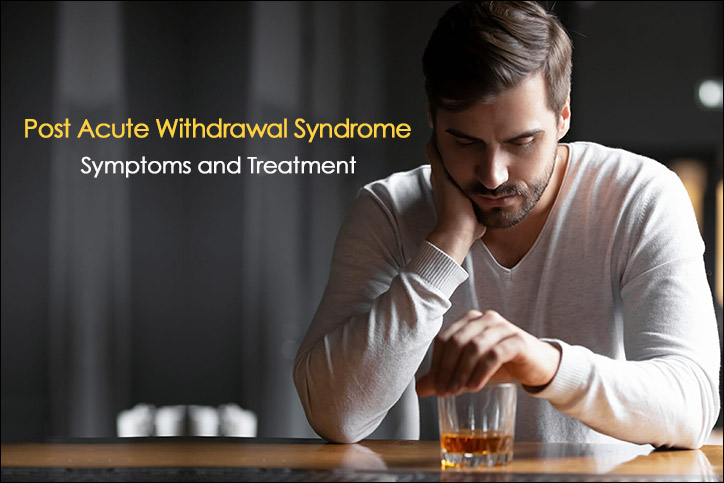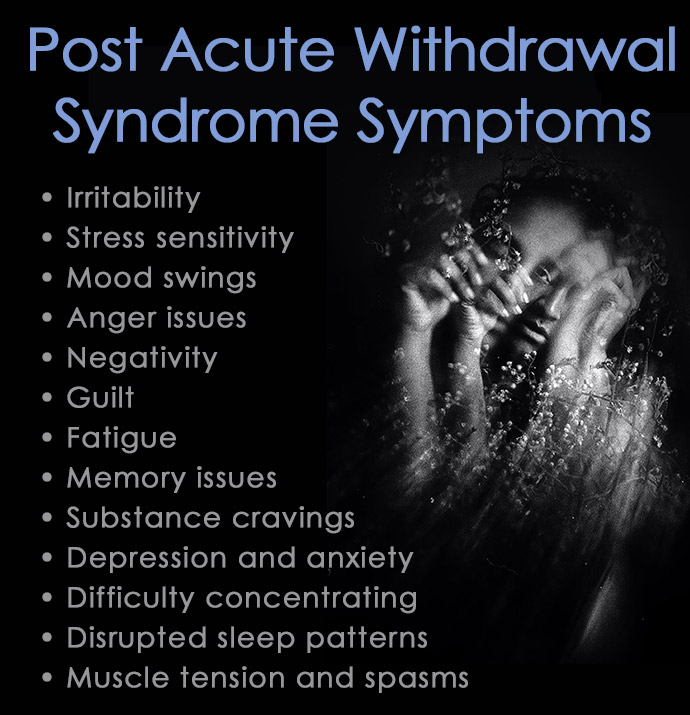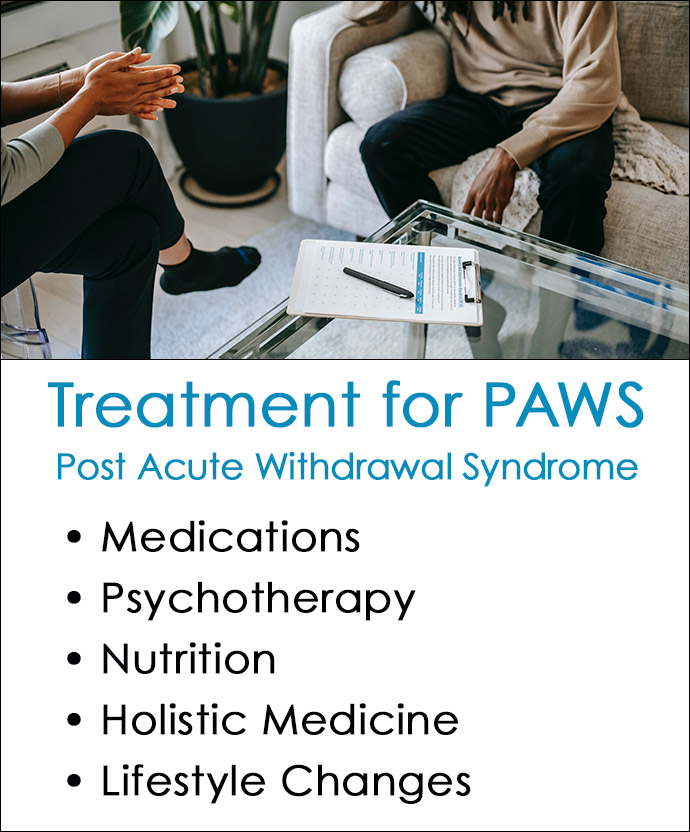Addiction recovery is extremely difficult. Even after completing detox and a rehab treatment program, many individuals continue to experience Post Acute Withdrawal Syndrome symptoms that may last for several weeks, months, or even years.
Many factors contribute to this condition, and the severity will vary for each individual.
Understanding what causes post acute withdrawal syndrome, identifying the symptoms, and seeking proper treatment can help make the long-term recovery process more successful.
What is Post Acute Withdrawal Syndrome (PAWS)?
Post Acute Withdrawal Syndrome, also known as PAWS, describes the physical and psychological symptoms experienced after the acute withdrawal phase of quitting drugs or alcohol subsides.
Anyone who has ever had a hangover after drinking alcohol has experienced a mild form of acute withdrawal. This usually goes away within a day or so.
If the hangover symptoms returned and continued for weeks or months, it would be considered post acute withdrawal symptoms.
While acute withdrawal usually begins within 8 hours after the last use of an addictive substance and peaks within 1 to 3 days, PAWS symptoms emerge later and can persist sporadically for weeks or months.
Unlike the flu-like symptoms of acute withdrawal, PAWS symptoms are generally expressed as emotional or cognitive issues.
This makes it difficult to control thoughts and emotions and may lead to mood swings, impulsiveness, and impaired decision making.
Individuals often struggle with routine responsibilities at home, work, or school, and many people lose a sense of joy in once pleasurable activities.
The continued withdrawal effects of PAWS symptoms are thought to be related to long-term brain function changes after prolonged addiction.
The areas of the brain that regulate executive functioning, impulse control, and self-regulation can take time to heal after chronic substance abuse.
Identifying and learning how to manage the uncomfortable symptoms of PAWS is crucial for successful long-term recovery.
What is the Difference Between Acute Withdrawal and Post Acute Withdrawal?
The main differences between acute withdrawal and post acute withdrawal generally pertain to the type of symptoms, when they begin, and how long they last.
Acute Withdrawal
- Usually occurs in the first 1 to 3 days after stopping substance use
- Primarily involves physical and medical symptoms
- Symptoms include nausea, vomiting, excessive sweating, hand tremors, insomnia, fever, and diarrhea
- Peak intensity is typically reached within the first 72 hours
Post Acute Withdrawal Syndrome (PAWS)
- Starts 5 to 7 days after the initial withdrawal period
- Mainly involves psychological and emotional symptoms
- Symptoms include depression, anxiety, irregular moods, fatigue, impaired cognition, and substance cravings
- Can persist off and on for weeks, months, or sometimes years, depending on the substance
Acute withdrawal relates to the immediate physical dependence the body has developed from addictive substances. Suddenly quitting the use of drugs or alcohol after prolonged use causes a flu-like illness.
Post-acute withdrawal is more closely associated with the long-term chemical changes in the brain caused by addiction. The healing process can require a long time for the brain’s neurochemistry to gradually return to normal functioning after being stimulated or controlled by drugs or alcohol.
Managing acute withdrawal usually requires a supervised medical detox, whereas PAWS symptoms rely more on psychotherapy, individual or group counseling, proper nutrition, lifestyle changes, and learning effective coping mechanisms.
Post Acute Withdrawal Syndrome Symptoms
Post acute withdrawal syndrome symptoms generally involve a variety of physical and emotional symptoms that will be different for each person.
When a person is addicted to alcohol or other drugs, their brain goes through chemical changes that adapt to that substance. PAWS occurs after a person is physically free of drugs and alcohol but is still dealing with the psychological side of sobriety.
Common PAWS Symptoms
- Irritability
- Stress sensitivity
- Mood swings
- Depression
- Anxiety
- Negativity
- Guilt
- Difficulty concentrating
- Memory issues
- Obsessive Compulsive Disorder
- Disrupted sleep patterns
- Fatigue
Mental Health Issues
Many recovering addicts battle conditions like depression, anxiety disorders, anger issues, unstable moods, or compulsive behaviors during post-acute withdrawal.
Emotions are often erratic and stress can quickly escalate into anxiety or panic attacks.
Weak impulse control, especially during stressful situations, can cause intense cravings to use alcohol or drugs to cope with the symptoms.
Frequent fits of anger and rage may spike when things become challenging.
Cognitive Impairment
PAWS frequently clouds rational thinking, focus, concentration, attention span, and memory retrieval.
Some individuals may become easily confused or are unable to complete routine tasks.
Carrying on conversations, processing new information, and work or school can be mentally and emotionally overwhelming.
Sleep Issues
Insomnia, sleep disturbances, having trouble falling or staying asleep, nightmares and cold sweats are typical with post acute withdrawal syndrome.
In turn, this causes daytime fatigue and drowsiness that has a negative impact on energy levels and overall quality of life.
Physical Pain
PAWS has shown to cause muscle tension and spasms, nerve pain, and general physical discomfort.
Flu-like aches and pains often occur in the form of headaches, stomach issues, and sensitivity to touch.
Increased Stress
Adjusting to sobriety after long-term substance addiction can be demanding, frustrating, and trigger overwhelming anxiety or a stress response.
Staying composed during stressful times becomes nearly impossible despite previously being able to stay calm and focused when under pressure.
Cravings and Urges
One of the most difficult symptoms of PAWS for many people in recovery is dealing with frequent cravings or urges to use drugs and alcohol.
While acute withdrawal typically ends most of the physical dependence, the psychological dependence can trigger the urge to drink alcohol or take drugs to relieve the mental and emotional pain of post acute withdrawal syndrome.
What Causes Post Acute Withdrawal Syndrome?
It’s difficult to know what causes post acute withdrawal syndrome for some people in recovery and not others.
However, research by the National Institute on Drug Abuse (NIDA) shows that chronic substance abuse causes significant changes to brain structure and function that requires substantial healing time.
Individuals with post acute withdrawal syndrome have deficiencies in neurotransmitters like dopamine, which regulates mood, motivation, and pleasure.
Serotonin imbalances also occur and cause symptoms like depression and anxiety.
Structural and functional changes to the brain’s prefrontal cortex from addiction lead to impaired memory, decision making, problem solving, and impulse control during post-acute withdrawal.
While it’s nearly impossible to point to a single root cause for PAWS, most individuals struggle to regain stability in brain processing after the effects of chronic substance use.
Since the brain controls every system and function in the entire body, the negative effects of addiction and withdrawal can cause physical and psychological symptoms until homeostasis returns to its natural baseline.
For most substance users in recovery, the brain begins to repair itself within several days or weeks after detox ends. However, some individuals deal longer recovery periods that may span many months.
Factors Related to PAWS Symptoms Duration
Genetics
Genetics impacts addiction and brain chemistry and may predispose certain individuals towards faster or slower recovery times.
Types of Substances
The types of substances used, combinations, and length of substance use contributes to withdrawal symptoms and duration. Some substances like benzodiazepines can take a very long time to heal from addiction and withdrawal.
Co-Occurring Disorders
Pre-existing mental health conditions like depression, PTSD, anxiety disorders, or trauma may exacerbate and sustain post acute withdrawal syndrome.
Nutritional Deficiencies
Malnutrition and nutritional deficiencies hamper the brain’s ability to heal and rebalance itself.
Length of Addiction
The longer an individual struggles with addiction, the more engrained the negative brain changes become. Deep-rooted changes will naturally take longer to heal and correct.
Is There a Difference Between Post Acute Withdrawal From Alcohol and Other Substances?
Yes, there are some differences in post acute withdrawal symptoms depending on the substance of addiction and are often related to the nature of the substance and its effect on the brain and body.
Alcohol
Common PAWS alcohol symptoms include impaired memory and concentration, sleep disturbances, mood swings, and persistent fatigue.
Psychological symptoms tend to be more prominent with alcohol PAWS given alcohol’s profound effects on brain chemistry.
Opioids
The most common opioid PAWS symptoms are intense cravings, anxiety, sleep issues, and sensitivity to physical pain.
PAWS from opioid addiction tends to involve more physical discomfort, like headaches, stomach issues, heart palpitations, or flu-like aches when compared to other substances.
Psychological symptoms such as impulsiveness and memory problems occur as well but generally prove less severe.
Benzodiazepines
Post acute withdrawal syndrome symptoms for benzodiazepines can be more troubling and complicated than other substances.
Prescription benzos like Xanax, Valium, and Klonopin are sometimes used to calm anxiety in early recovery from other substances.
However, benzodiazepines also carry a high risk of dependence and addiction even when taken as prescribed. When a user quits taking them it can cause acute withdrawal like with alcohol or opioids.
Rebound anxiety can occur while withdrawing from benzodiazepines after heavy use and create psychological PAWS symptoms.
When compared to other substances, PAWS symptoms peak later and last longer when withdrawing from benzodiazepines. Lingering and recurring anxiety, depression, and sleep disruptions can last for 6 months to more than 2 years for some individuals after long-term benzodiazepine use.
Benzodiazepine withdrawal also has a negative impact on GABA neurotransmitters that are needed to calm mood and excitability.
Because of the complex nature of benzos and withdrawal, they require specialized benzodiazepine detox and addiction treatment to manage and recover from PAWS symptoms.
Other Substances
Stimulant withdrawal often keeps energy levels low, may trigger eating disorders, and cause rapid heart rates or hypertension.
Marijuana PAWS frequently induces appetite changes, headaches, loss of focus, and sleep disruptions.
Treatment for Post Acute Withdrawal Syndrome
Fortunately, the brain is able to adapt and heal through proper treatment for post acute withdrawal syndrome.
There is no standardized form of treatment for PAWS because each person and substance is different, and factors like the amount and length of use should be considered for recovery.
PAWS treatment usually involves a mix of medications, psychotherapy, nutrition, holistic medicine, and lifestyle changes to be successful.
Medications
Medication Assisted Treatment can be helpful and may include anti-anxiety medicines, antidepressants, and other pharmacological therapies to temporarily rebalance neurotransmitter issues that cause emotional or cognitive problems.
Certain types of medications may also assist with pain, drug cravings, and sleep issues.
Psychotherapy
Counseling and evidence-based therapies for addiction offer healthy coping strategies for negative thinking and behavior patterns that often contribute to PAWS symptoms.
Talk therapy can identify unhealthy psychological issues and cognitive behavioral therapy and similar approaches help overcome triggers, cravings, and relapse temptations.
Proper Nutrition
Eating a balanced and healthy diet ensures an essential intake of vitamins, minerals, and nutrients that are necessary to repair the brain.
Vitamin IV therapy for addiction detox is also effective for replenishing vital nutrients to ease depression, fatigue, and other symptoms.
Holistic Medicine
Relaxation techniques, massage, acupuncture, mindfulness, and meditative movements like yoga are helpful for reducing stress, anxiety, pain, and sleep troubles during PAWS.
Lifestyle Changes
Adopting lifestyle changes and practicing self-care is crucial throughout post acute withdrawal syndrome. Regular exercise and getting adequate, restful sleep at the same time every night will enhance physical and mental well-being.
In many cases, PAWS symptoms will begin to settle down after six months of sobriety, although some people may experience occasional bouts for a year or more depending on the type of substance.
Post acute withdrawal syndrome is not without its ups and downs, but over time, treatment and therapy will offer most people a full recovery and return to a healthy life.






